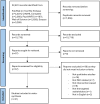Exploring prehospital emergency care challenges and interventions to reduce emergency department overcrowding: a qualitative meta-synthesis
- PMID: 40803743
- PMCID: PMC12352181
- DOI: 10.1136/bmjopen-2024-097457
Exploring prehospital emergency care challenges and interventions to reduce emergency department overcrowding: a qualitative meta-synthesis
Abstract
Background: Challenges within prehospital emergency care (PEC) have significant implications for the provision of emergency department (ED) care. However, ED overcrowding is a prevalent issue with negative impacts on patient outcomes. It can be attributed to multiple factors, such as non-emergency attendances, inaccessible alternative care service pathways (ACSPs) and inefficiencies in emergency medical service operations. ED overcrowding has prompted healthcare systems worldwide to implement interventions. These include tele-triaging, virtual ED and non-conveyance protocols that primarily aim to reduce demand for ED care and increase the supply of alternative services. However, despite such efforts, there remain unaddressed limitations that prevent PEC interventions from being successfully implemented. Moreover, prior studies and reviews have found mixed results, and that ED overcrowding interventions remain underused. Therefore, there is a need for this qualitative systematic review and meta-synthesis to capture the complexities of implementation challenges and identify enablers required to complement PEC interventions.
Objectives: This systematic review and meta-synthesis aims to offer a consolidated overview of PEC interventions intended to reduce ED overcrowding. It focuses on presenting international perspectives on the current challenges these interventions face. The enablers presented in this review could also better inform the actions taken by healthcare systems aiming to implement similar interventions.
Methods: A comprehensive search of PubMed, Embase, Cumulative Index to Nursing and Allied Health Literature Complete, PsycINFO, Web of Science and Scopus was conducted to obtain a set of qualitative studies. Following a quality appraisal with the Critical Appraisal Skills Programme tool, data from the included studies were extracted and meta-synthesised.
Results: A final 21 qualitative intervention-based studies were included. Through these studies, four themes were identified: (1) types of PEC interventions to alleviate ED demands and right-site patients, (2) perceived benefits of interventions, (3) challenges in implementing interventions and (4) key enablers for successful implementation of interventions. Our results describe key factors such as the importance of ACSPs and support for PEC healthcare workers in the form of standardised guidelines, as well as education and training.
Conclusion: We further discuss how enablers can integrate into current PEC systems to complement the interventions explored. Discussions are concentrated on several key interventions (tele-triaging, virtual ED and non-conveyance protocols) as they were perceived to hold significant potential in addressing PEC challenges and could be further elevated through various enablers. Overall, we could conclude that each intervention needs to be complemented by enablers to optimise its benefits.
Keywords: Emergency Departments; Health policy; International health services; Systematic Review.
© Author(s) (or their employer(s)) 2025. Re-use permitted under CC BY-NC. No commercial re-use. See rights and permissions. Published by BMJ Group.
Conflict of interest statement
Competing interests: None declared.
Figures



Similar articles
-
Prescription of Controlled Substances: Benefits and Risks.2025 Jul 6. In: StatPearls [Internet]. Treasure Island (FL): StatPearls Publishing; 2025 Jan–. 2025 Jul 6. In: StatPearls [Internet]. Treasure Island (FL): StatPearls Publishing; 2025 Jan–. PMID: 30726003 Free Books & Documents.
-
Health professionals' experience of teamwork education in acute hospital settings: a systematic review of qualitative literature.JBI Database System Rev Implement Rep. 2016 Apr;14(4):96-137. doi: 10.11124/JBISRIR-2016-1843. JBI Database System Rev Implement Rep. 2016. PMID: 27532314
-
Factors that influence participation in physical activity for people with bipolar disorder: a synthesis of qualitative evidence.Cochrane Database Syst Rev. 2024 Jun 4;6(6):CD013557. doi: 10.1002/14651858.CD013557.pub2. Cochrane Database Syst Rev. 2024. PMID: 38837220 Free PMC article. Review.
-
Interventions to improve safe and effective medicines use by consumers: an overview of systematic reviews.Cochrane Database Syst Rev. 2014 Apr 29;2014(4):CD007768. doi: 10.1002/14651858.CD007768.pub3. Cochrane Database Syst Rev. 2014. PMID: 24777444 Free PMC article.
-
[Volume and health outcomes: evidence from systematic reviews and from evaluation of Italian hospital data].Epidemiol Prev. 2013 Mar-Jun;37(2-3 Suppl 2):1-100. Epidemiol Prev. 2013. PMID: 23851286 Italian.
References
-
- Andersson G, Karlberg I. Lack of integration, and seasonal variations in demand explained performance problems and waiting times for patients at emergency departments: a 3 years evaluation of the shift of responsibility between primary and secondary care by closure of two acute hospitals. Health Policy. 2001;55:187–207. doi: 10.1016/s0168-8510(00)00113-5. - DOI - PubMed
LinkOut - more resources
Full Text Sources
